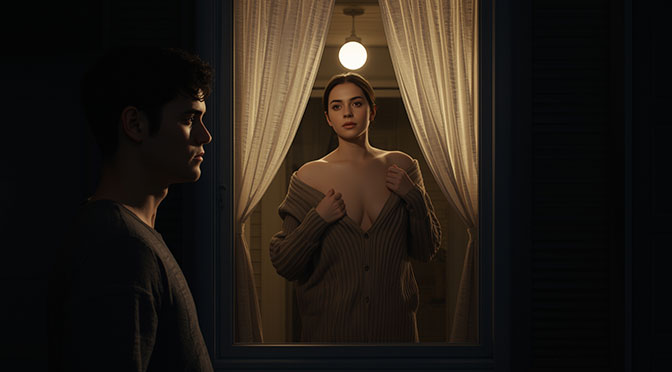Who’s watching whom?
At the heart of every erotic scene lies the gaze. It defines who holds control, who desires, and who is reduced to being seen. Yet too often, literature repeats an old choreography: a man looks, a woman is looked at, and the text follows his desire.
Modern erotic writing demands a reversal of this gaze. It asks: What happens when the one being observed begins to see?
Voyeurism is not only a theme — it’s a dramatic principle. It creates tension through asymmetry: one person knows more than the other. But once you reverse that hierarchy, something fascinating happens. The observed becomes aware of the observer — and both begin to change.
The classic version: the gaze as control
In the traditional voyeuristic setup, someone watches secretly — through a crack, a window, a lens.
Example: A man stands outside a woman’s apartment at night. She undresses before the open window, unaware of his presence.
The tension comes from unequal perception: he sees what she cannot. His excitement feeds on secrecy. But the structure itself is one-sided. The watcher holds the power; the observed remains passive.
Dramaturgically, the scene reproduces the same hierarchy it pretends to expose.
The reversal: the gaze as mirror
Now flip it.
She knows she is being watched. Perhaps she noticed the movement outside earlier — and decides to continue anyway. She slips off her sweater, slower than necessary, and lets her eyes rest for a moment on the dark windowpane.
Now the act of seeing becomes an exchange. The gaze returns.
At that point, voyeurism transforms into self-staging. She turns the act of being seen into a performance. The watcher loses control without realizing it. Nothing has changed except perception — and that shift is everything.
Tension now arises not from secrecy but from awareness. Two consciousnesses intersect, and the scene becomes electric — not because of contact, but because of mutual recognition.
Perspective and camera – who tells the image?
Every voyeuristic moment depends on point of view. From the observer’s perspective, you create curiosity or guilt. From the observed’s, exposure or defiance.
But the most charged scenes occur when the narrative camera switches.
Imagine this:
An acting student rehearses alone in a studio. A teacher watches through the control booth, thinking she doesn’t know. Suddenly she looks directly into the camera — and for an instant, he becomes the one being seen.
She continues her monologue, but every line now carries a double meaning.
That is the catharsis of the gaze: when the voyeur loses the distance that once protected him.
Seeing as action
Looking is never passive. To look is to act, to claim space. To be looked at — and to return the gaze — reshapes both sides.
When writing, ask yourself:
– Who holds visual power in this scene?
– When does it shift?
– Who narrates the image?
Reversing the gaze doesn’t require new plot; it requires new perception. The act of observation becomes an encounter.
Writing Prompt
Write a scene in which someone knows they are being watched — and begins to play with that awareness.
Show how the gaze changes shape.
In erotic writing, power lies not in who is naked, but in who dares to look back.

